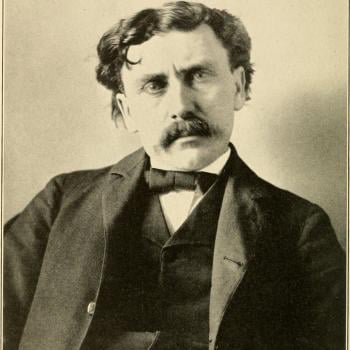I have blogged a lot on themes of paganism, “folk horror,” and witchcraft, so this particular post follows naturally. This is my review of one of this past year’s really impressive books.
Ronald Hutton, The Witch: A History of Fear, from Ancient Times to the Present (Yale University Press, 2017). 360 pages + xv.
Ronald Hutton’s The Witch is a fine book in its own right, insightful and thoroughly researched. It gains greatly in value when understood as part of the career trajectory of an impressive polymath scholar who remains far better known in Britain than in the US.
Hutton is a laudable example of a historian gone rogue. He began his career in the early 1980s, studying the rather conventional field of seventeenth century Britain (which incidentally is where my own scholarly career began). He developed an interest in the ritual year as it was known at that time, the cycle of festivities and celebrations that corresponded roughly to the medieval church year. At the time he wrote, there was a lively belief in popular culture – and to some extent in academe – that such celebrations retained a still more significant imprint from ancient paganism, and that archaic rituals had somehow been converted or adapted under a thin Christian veneer.
A belief in such very long continuities manifested in claims that modern day neo-pagans and Wiccans were in some sense the authentic heirs of old pagan traditions that had remained semi-clandestine for centuries. Through the Early Modern period, it was suggested, those hypothetical underground faiths had sporadically been exposed in the notorious witch-hunts. In the 1960s and 1970s, these ideas were widely popularized by the thriving British genre of Folk Horror, films and novels in which unwary strangers stumbled into the clutches of lethal pagan sacrificial cults lurking in modern–day villages and suburbs. (Think of The Wicker Man). Britain’s bloody religious past was not dead: it was not even past.
Hutton regarded such claims of pagan continuity as wholly misguided, and his scholarly efforts to reconstruct the authentic origins of modern day neo-paganism and witchcraft consumed the next phase of his career. In very influential books such as The Triumph of the Moon (1999), he showed irrefutably how and why that modern day pagan synthesis had been concocted. He focused particularly on the creative fictions of buccaneering literary entrepreneurs like Gerald Gardner, and deluded witchcraft fantasists like Margaret Murray. Neo-paganism and Wicca, Hutton argued, might be quite genuine new religious movements, but they were indeed new, and invented, and had no genuine roots before the early twentieth century. His arguments about Fake History were fiercely debated within the neo-pagan world, especially in North America, but they have now been largely accepted.
Even those with no interest in the specific topic of neo-paganism can learn much from Hutton’s acutely critical historical method. Repeatedly, he takes modern myths about supposed pagan survivals and through painstaking archival research he shows convincingly how these ideas originated in the accumulated fantasies and obsessions of successive centuries. Through those eras, scholarly speculations interacted with popular culture, as each worked with the other to build an ever more awe-inspiring castle of dreams and nightmares. Seeking the origins and foundations of such ideas, though, the historian generally finds that when you get there, there is no there there.
In recent years, Hutton has published extensively on aspects of paganism, witchcraft and druidry, always demonstrating a commendable zeal to draw on disciplines far beyond his home field of history, venturing deep into anthropology and archaeology. He is very comfortable with global and transnational comparisons.
The Witch thus fits precisely into this long scholarly arc. Among its many strengths is its global approach. That may sound unremarkable, but Hutton offers an excellent and rather startling narrative of how anthropologists of the past generation or so came to reject any attempts to compare contemporary non-European witchcraft with the behaviors we observe in, say, seventeenth century England. He seeks to restore the study of witchcraft as a cross-cultural phenomenon, a task that is essential and, one would think, it should be uncontroversial.
Hutton spends much space on defining his terms, drawing careful distinctions between witchcraft, sorcery, and magic, and applying the witchcraft label only where strictly appropriate according to his terms. Ancient Egyptians, he says, had no concept of witchcraft, but they did believe in hostile magic and specifically the Evil Eye. To the untrained eye, evil or otherwise, that sounds a lot like what I would call witchcraft. Anyway, here is Hutton’s meticulous definition: a witch is taken to be an alleged worker of destructive magic, “somebody believed to use magic for harmful purposes.” I will neither explore nor observe his distinctions too closely in a review of this length, except to say that his precision is admirable.
In the popular mind, witches are a distinctly Early Modern phenomenon, and moreover Euro-American, so they are generally imagined as women wearing the distinctive hats and garb of England or Germany around 1640. The standard American vision is that of Salem in 1692, as refracted through Arthur Miller’s Crucible, in which harmless and even virtuous people are used as scapegoats for the fears and nightmares of a conflicted and intolerant society, driven by repressive religion and profound misogyny. They are victims of Puritanism par excellence.
We can certainly find historical examples that fit this stereotype, but there is so much more to the story. Not only do witchcraft fears long predominate the Reformation era, or Christianity itself, but as far as we can speak in such terms, they are close to universal. Significantly, Hutton does not really focus on the Early Modern experience until midway through the present book.
So widespread are witchcraft ideas, so globally distributed, that the related assumptions seem to be deeply rooted in the human consciousness, perhaps even hard-wired in the human brain. The fundamental theory is that bad things do not just happen, they are inflicted by human agency, and that it is imperative to find the person responsible, both to retaliate, but also to prevent further wrongdoing. In his recent book Inside the Whirlwind, Jason Carter tells a chilling story from a Christian community in contemporary West Africa. He quotes an elderly Presbyterian woman who remarks that, “In our culture, friendship is not deemed friendship until a child dies.” “In other words,” says Carter, “only when retributive blame and witchcraft accusations are not directed at family members and friends during a crisis is that friendship counted as genuine.”
No less universal is the wish to believe that effective responses do exist for illnesses and misfortunes, and that these are controlled by ritual specialists of various kinds – often by what Hutton terms “service magicians.” The problem then is that, during times of chaos or mass despair, it is precisely these benevolent magicians and charmers who fall under immediate suspicion as evil witches.
Witchcraft ideas might be universal, but the structures of society and organized religion in a specific community decide how they will be interpreted and constructed into a larger framework. The key variables will then include the belief structure of the larger society, but also the official means of detecting and investigating witchcraft. In Continental European history, one major reason why witchcraft panics reached such epic proportions between about 1550 and 1680 was that Roman Law countries followed inquisitorial prosecutorial methods, supported by the extensive use of torture. Suspects faced overwhelming pressure not just to confess, but to implicate ever more individuals, and to confirm the witch-hunters’ speculations about far-reaching diabolical conspiracies. In turn, the rise of printing circulated emerging ideas about devil-cults, and gave inquisitors a rich panoply of questions which they would ask of suspects. Neither for the first time nor the last, the rise of modernity actually promoted the belief in witchcraft, rather than discouraging it.
European countries thus developed the florid mythology of the witch cult as a whole anti-Christian subterranean religion, whose devotees gathered at orgiastic Sabbats. England, in contrast, forbade judicial torture, so that witchcraft charges remained strictly limited and localized, and the idea of the Sabbat never sank local roots. English witchcraft was thus punished as a supernatural form of assault or murder, not as heretical ritual. Meanwhile, Roman Law Scotland did torture, and regularly claimed to find Satanic cults and Sabbats.
As those ideologies and stereotypes become established, so they shaped the thought of individuals who actively adopted the prevailing witch image, and even voluntarily boasted of their sinister powers. However cynical some of the witch-hunters might have been, they often were dealing with people who genuinely did believe they wielded occult powers, and who confessed accordingly. As a side note, such psychological processes are brilliantly described in two of the finest historical films of recent years, the American production of The Witch (2015) and the stunning Swedish/Finnish film The Devil’s Bride (Tulen Morsian, 2016).
Although the Satanic Witch cult/Sabbat idea was not universal, it was very widespread. Many societies through history, and on several continents, have linked witches to imaginary cults that scorned all the assumptions of proper society. According to this nightmarish vision, each individual group is organized on tightly disciplined and hierarchical lines, and keeps tight secrecy. The groups’ practices are based on a principle of inversion, reversing all the norms and standards of civilized society, praising or worshipping principles like death, chaos, anarchy and evil. This principle characterizes the rituals of the sects, especially the initiation practices, which involve extreme acts of violence or sexual perversion. The sects’ alleged rituals involve a variety of practices that include the sacrifice of animals and humans; sexual rituals featuring every conceivable perversion; cannibalism and the consumption of loathsome foods; grave robbery and corpse abuse; orgiastic gatherings featuring bizarre ritual music and dancing. Evil cults particularly targeted children or babies. In ages of high infant mortality, evidence of witch atrocities was seldom lacking.
So were there ever real witches? I remarked earlier how Hutton demolished the case made by Gerald Gardner and others for Wicca being an authentic ancient paganism. Yet Hutton remains open to continuity arguments when properly advanced and substantiated, and he pays respectful attention to tantalizing evidence of the survival of shamanism in various parts of Europe. Drawing no firm conclusions, he discusses how such ancient forms might have affected later witch beliefs.
Witch persecutions did not begin in Early Modern Europe, nor did they end then. One curious pattern in European witchcraft history is how they progressed very slowly east and north across Europe from the fifteenth century onwards. The worst Swedish incidents did not develop until the end of the seventeenth century, and Poland and Russia experienced some of their worst nightmares in the eighteenth.
And of course, there is so much more to the story than Europe. Witchcraft remained, and remains, a deeply inlaid part of African religious belief, and much of the modern history of the expansion of African Christianity can be written in terms of how churches came to terms with witchcraft beliefs and anti-witchcraft movements. Contrary to expectations, not only have witch fears not perished with modernity – with globalization and urbanization – but they seem to be entering a new phase of intensity. Witches are just as likely to be lynched in today’s sprawling African mega-cities as in remote bush villages. The experienced hunter or detector of African witches can count on a career as long and lucrative as could his or her counterparts in seventeenth century Germany. In the present century, European societies have had to respond to African witch-fears and “witch churches”, and the media have commonly done so by adopting and reinforcing racist stereotypes borrowed directly from the Heart of Darkness.
The Witch is a major contribution to scholarship, all the better for not following the well trodden path of familiar cases, all the familiar heroes and villains: even Cotton Mather makes no appearance! Particularly interesting are three major chapters on commonalities in British witchcraft beliefs, namely the relationship between witches and fairies; witches and animals; and witches and Celticity. In each instance, so rich is his material that any one of these chapters might have spun off into a full-length book in its own right, and who knows, it might yet do so.
A terrific book on a pressing global issue of the 21st century.













